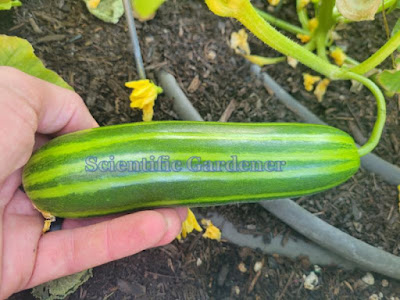It took several years for me to be able to harvest a good crop of my best Cucumis melo variety conomon. While most Asian pickling melons tend to be bitter, this striped Indonesian variety is very tasty when picked immature.
The primary reason why I wanted to grow out the Timun Krai is because it produces well in a hot humid climate. There tend to be very few muskmelon varieties that tolerate those conditions and I felt that growers in places like the Southeastern United States should have the opportunity to grow something that might work in their region. That being said, I cannot say if the variety exhibits any resistance against the notorious pickleworm.
One of the most interesting things about the conomon varieties is that they have physical traits that remind the grower of both Cucumis sativus (regular cucumbers) and cylindrical Cucumis melo (muskmelons). The flowers look somewhere between sativus while the spiny stems are more reminiscent of the latter. The fruit itself is absent of spines, but also lacks the longer fuzz of the carosello or other flexuous muskmelon varieties. Instead, there are extremely short, hardly noticeable thin hairs.
Like the Indian Ayra, the Timun Krai tends to ooze red sap in places where the fruit or vine are damaged. It can be a bit surprising to the grower is she is not acquainted with this specific characteristic.
Overall, I would definitely grow out the Timun Krai again. Compared with regular Cucumis sativus cucumbers, it is quite good. The only concern I have is that there is a slight possibility that the fruit can be bitter due to the bitterness of other varieties of the same genetic heritage.













































































